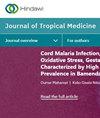墨西哥尤卡坦州皮肤利什曼病暴发点野生啮齿动物感染墨西哥利什曼原虫
IF 2.1
4区 医学
Q3 PUBLIC, ENVIRONMENTAL & OCCUPATIONAL HEALTH
引用次数: 7
摘要
2015年,墨西哥尤卡坦州天宁市报告了局部皮肤利什曼病(LCL)的紧急病例。作为生态流行病学研究的一部分,以确定该地区引发利什曼原虫感染的因素,我们进行了一项实地研究,以调查野生啮齿动物中利什曼原虫感染的发生情况。从2019年11月到2020年2月,尤卡坦州天宁市的三个地点捕捉到了啮齿动物。对于每个标本,都记录了提示利什曼原虫感染的临床症状。从尾部、肝脏和脾脏采集样本,通过PCR鉴定利什曼原虫DNA。捕获了20只啮齿动物,分属两个物种,包括高梅里异尾鼠(55%,11/20)和叶斑Ototylomys phyllotis(45%,9/20)。55%的动物尾巴上有白斑,15%有脾肿大,5%有肝肿大。55%(11/20)的动物被发现感染了利什曼原虫。所有诱捕点均捕捉到高梅里异鼠,感染率最高(63.6%,7/11)。感染率为44.4%(4/9)。墨西哥利什曼原虫(Leishmania mexicana)被鉴定为两种高meri的感染种。这项研究首次提供了尤卡坦州野生啮齿动物感染利什曼原虫的证据。在这个新出现的焦点中,gaumeri和O.phyllotis可能参与了墨西哥乳杆菌的传播周期;然而,还需要进一步的纵向研究来证实它们作为主要储层的作用。本文章由计算机程序翻译,如有差异,请以英文原文为准。
Leishmania (Leishmania) mexicana Infection in Wild Rodents from an Emergent Focus of Cutaneous Leishmaniasis in Yucatan, Mexico
In 2015, emergent cases of localized cutaneous leishmaniasis (LCL) were reported in Tinum, Yucatan, Mexico. As part of an eco-epidemiological study to characterize the elements that trigger Leishmania infection in that area, we conducted a field study to investigate the occurrence of Leishmania infection in wild rodents. From November 2019 to February 2020, rodents were caught from three sites located in the municipality of Tinum, Yucatan. For each specimen, clinical signs suggestive of Leishmania infection were recorded. Samples from the tail, liver, and spleen were taken for the identification of Leishmania DNA by PCR. Twenty rodents belonging to two species were caught including Heteromys gaumeri (55%, 11/20) and Ototylomys phyllotis (45%, 9/20). Fifty-five percent of the animals presented white spots on the tail, 15% had splenomegaly, and 5% had hepatomegaly. Fifty-five percent (11/20) of the animals were found infected by Leishmania. Heteromys gaumeri was caught in all trapping sites and was the most infected species (63.6%, 7/11). The percentage of infection for O. phyllotis was 44.4% (4/9). Leishmania (Leishmania) mexicana was identified as the infecting species in two H. gaumeri. This study provides, for the first time, evidence of Leishmania infection in wild rodents from the Yucatan state. Heteromys gaumeri and O. phyllotis may be involved in the transmission cycle of L. mexicana in this emergent focus; however, further longitudinal studies are needed to confirm their role as primary reservoirs.
求助全文
通过发布文献求助,成功后即可免费获取论文全文。
去求助
来源期刊

Journal of Tropical Medicine
Immunology and Microbiology-Parasitology
CiteScore
3.90
自引率
4.50%
发文量
0
审稿时长
14 weeks
期刊介绍:
Journal of Tropical Medicine is a peer-reviewed, Open Access journal that publishes original research articles, review articles, and clinical studies on all aspects of tropical diseases. Articles on the pathology, diagnosis, and treatment of tropical diseases, parasites and their hosts, epidemiology, and public health issues will be considered. Journal of Tropical Medicine aims to facilitate the communication of advances addressing global health and mortality relating to tropical diseases.
 求助内容:
求助内容: 应助结果提醒方式:
应助结果提醒方式:


